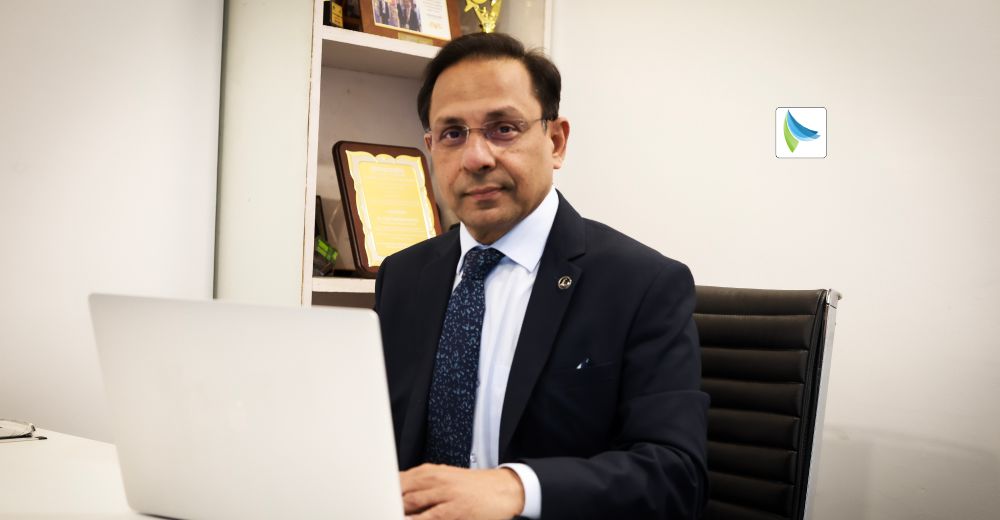Water is life and more than simply a resource for a state like Haryana, which is home to one of India’s best agricultural belts. It is also essential for environmental balance, rural economies, and food security. However, Haryana is currently facing severe water problems: groundwater levels are dropping to dangerously low levels, waterlogging with soil salinity in increased areas, old irrigation equipment is breaking down, supply is not keeping up with demand, and climate change is only waiting to highlight the delicate balance. In addition to technological answers, such intricate situations demand innovative, intelligent leadership that blends public discourse, research, and policy.
Leading this transformation is Dr. Satbir Singh Kadian, a visionary leader whose leadership personifies such an integrated vision. For more than two decades, Dr. Kadian has been at the helm of transforming Haryana’s water management infrastructure to be efficient, equitable, and sustainable. His work goes far beyond engineering achievements, reaching to community empowerment, institutional reforms, and path-breaking vision goals adopted as a model of water security not only in Haryana but across India.
Rooted in Rural Wisdom, Rising with Global Knowledge
Dr. Satbir Singh Kadian hails from a small village called Beholi in the Panipat district of Haryana. Dr. Satbir Singh Kadian is a farmer by profession, and a family man, who understood the cycles of rural life and the importance of water in protecting his people’s health. Dr. Satbir Singh Kadian’s father was a proud member of the community council in his village, teaching him values of service, honesty, and accountability.
Ever since a very early age, Dr. Satbir Singh Kadian has had this voracious appetite to inquire and learn. He was always at the top in primary school and secondary school, receiving state-level awards more than once. With a zealous desire to solve real-life issues, he went on to study Mechanical Engineering at the illustrious Thapar Institute of Engineering & Technology and graduated in 1992 with honors.
But Dr. Satbir Singh Kadian’s education was not limited to books. He saw the sheer need for integrating policy and technology and sustainability. This vision led him to the Indian Institute of Technology (IIT) Delhi, where he finished his integrated Ph.D. in Functional ERP Systems and Sustainability by 1998. The uncommon mix put him at the crossroads of engineering, environmental protection, and systems management.
With a zeal to learn, he pursued an executive education course on management at Harvard University on entrepreneurship in developing economies; a set of skills essential to turning ideas into public initiatives that can be scaled.
Concurrently, learning through the MASHAV program in Israel provided him with the current advances in water management, technology, and economics that would be most useful in semi-arid and water-scarce states like Haryana.
This strong combination of technical prowess, global exposure, and national insight was the cornerstone of Dr. Kadian’s successful career committed to resolution of the water crisis in Haryana.
From Decline to Delivery: A Landmark Canal Rehabilitation Led by Vision and Innovation
Dr. Satbir Singh Kadian joined the Haryana Irrigation Department upon graduation, a field of utmost significance given the state’s overdependence on canal irrigation and groundwater. In his formative working years, he witnessed firsthand the sorry condition of the Jawaharlal Nehru (JLN) Lift Canal System, a key irrigation channel built in the 1970s that had lost its efficiency over the years. The canals and LYRIC pumps were uneconomical, the majority of parts unused, resulting in water shortages in tail-end regions and deterring farmers’ potential.
Rather than succumbing to this ongoing decline, Dr. Satbir Singh Kadian took it as a challenge. Leaping Himalayan bounds from his technical experience and managerial skills, he spearheaded a pioneering project to rejuvenate and modernize the entire lift canal system. Funded by more than $10 million of NABARD money and equipped with state-of-the-art technology such as SCADA (computerized control systems), AI-based predictive maintenance, and telemetry-based monitoring, the rehabilitation got the canal system back on track for full, reliable function.
The impacts were spectacular. Over a million people were directly impacted by augmented availability of irrigation, enhanced utilization of safe water, increase in crop yield, and migratory pressure from drought in source regions lessened. The rehabilitation also ensured long-term viability of the facilities through rigorous quality standards that ensured a minimum life of 20 years of utility; with long vision turning out to be true.
Due to his emphasis on transparency and accountability, this project was an open model for infrastructure management that received high-profile awards such as the CBIP Award for Distinguished Operations and the Central Water Commission award.
Pioneering Water Governance at State and National Levels
Dr. Satbir Singh Kadian’s experience widened quickly to larger responsibility: Engineer-in-Chief Irrigation & Water Resources Department of Haryana, CEO Haryana Water Resources Authority (HWRA), and Administrator of MICADA, the organization which is designing micro-irrigation and command area development.
He applied experience-based engineering with policy-making and institutional reform in these roles, directing large-scale programs that have transformed water management in Haryana:
-
Atal Bhujal Yojana (AbhY): Groundwater Sustainability through Community Ownership
With the launch of Atal Bhujal Yojana, the flagship programme of the Ministry of Jal Shakti, Dr. Satbir Singh Kadian initiated the Community-Based Participatory Approach (CBPA). Contrary to the conventional top-down groundwater management plans, his method strengthens the grassroot Panchayati Raj Institutions and women volunteers called “Bhujal Sahelis” in the task of evaluating, planning, and implementing water-conservation activities. This participatory strategy enabled villages to plan their water security independently, from scientific groundwater information but guided by local experience and need. Campaigns for water conservation, awareness campaigns, and behavioral changes picked up speed gradually, which stabilized the rate of groundwater in most districts.
-
Jal Shakti Abhiyan & National Hydrology Project
Incorporating real-time data systems has been the hallmark of Dr. Satbir Singh Kadian’s efforts. Haryana’s role in Jal Shakti Abhiyan is rainwater harvesting, reviving traditional water bodies, and natural aquifer recharging. Supplementing the real-time groundwater level data of the National Hydrology Project and computer modeling, these initiatives have pro-active, science-based management of the precious resource.
State Vision 2047 and Integrated Water Resources Action Plan (IWRAP)
Moving towards the future, Dr. Satbir Singh Kadian has contributed significantly towards Haryana’s vision for the future through the creation of the Vision 2047 document and imagining the Integrated Water Resources Action Plan (IWRAP). These developments suggest a road map for water management in a climate-resilient manner, from surface and groundwater management to land use planning, dynamic water pricing, and institutional change.
The Water Secure Haryana plan, valued at Rs. 5700 crore and currently placed on the World Bank list of finances, is an expression of this vision, uniting sustainable practice, technology, nature-based solutions, and multi-stakeholder coordination.
Water as a Collective Responsibility: Engaging Communities for Change
Dr. Satbir Singh Kadian understands that technology alone will never provide sustainable water resources without active people’s involvement. His leadership has given new life to outreach programs with creativity and passion:
- Bhujal Sahelis: Ground water women volunteers who are neighborhood leaders in their own area lead other villagers towards appropriate water conservation and adopting sustainable irrigation. They have propagated conservation practices through believed presence in villages.
- Nukkad Nataks (Street Theatre): Street theatre and folk narrative forms bring abstract hydrogeology into the lives of people on a daily basis. The plays resonate with rural communities at both a cultural and emotional level, and water conservation is a local source of pride rather than an official decree.
- Bhujal Raths (Mobile Education Vehicles): They are equipped with knowledge content, real-time water data, and interactivity engagement facilities and move in a circular pattern to remote villages from time to time as on-the-move classrooms filling up knowledge gaps at farmers’ doorstep.
These ground-level mechanisms are the pillars on which the success of schemes like Atal Bhujal Yojana is based and have changed water from a scarce to an available commodity.
International Collaboration and Knowledge Exchange
A visionary internationalist, Dr. Satbir Singh Kadian has established the following partnerships:
- Israel: Collaboration under the MASHAV program and bilateral governmental agreements have introduced Israeli technology of reuse of wastewater, intelligent irrigation, water management, and capacity building to Haryana. Israel’s model of water conservation in city governance guides top Haryana initiatives.
- Finland: Applying Finnish models of urban water body renewal through cooperation programs like the Sukhrali Pond renewal in Gurugram, with emphasis on nature-based restoration activities.
- World Bank and UNDP: Kadian’s interaction with these global agencies led to offering advice on aligning Haryana’s water governance with global best practices while developing solutions that were suitable for India’s social as well as ecological environments.
This global vision reconciles innovation and tradition so that Haryana’s water fate is guided by world wisdom but rooted locally.
Accolades for Leadership, Legacy, and Lasting Change
Dr. Kadian’s work has been valued far and wide:
- CBIP Award (2018) for outstanding working of lift canals.
- National Water Award (2018) for water conservation in Rewari district.
- Atal Bihari Vajpayee Good Governance Award (2020) in Haryana for recharge of groundwater.
- Water Digest Award (2022-23) for groundwater governance and management.
- SKOCH Order of Merit and Gold Awards (2023, 2024) for state-level water governance.
- Indian Achievers’ Award (2024) for his leadership role in groundwater management.
Over 30 other awards, from local bodies to international organizations, not only speak of his technical and managerial abilities but also his commitment to honest and transparent administration.
A Broader Legacy: Sustainable Rural Development and Cultural Renaissance
Dr. Kadian’s goal extends beyond water. He has transformed his own agriculture fields in village Beholi in District Panipat, Haryana, into the model for sustainable living. Organic farming, micro irrigation with solar-powered pumps, rainwater harvesting structures, and crop diversification practices have been seamlessly integrated to demonstrate how traditional farming can align with modern sustainability goals. His farm not only yields healthy produce but also serves as a live learning lab for farmers, students, and policymakers, inspiring a broader shift toward environmentally conscious rural development.
On the social side, as patron sponsor of SATVIK ARTs, Dr. Satbir Singh Kadian is sponsoring theater groups that restore the age-old native tradition of narration. Their plays, award-winning everywhere across the globe, portray cultural heritage and green awareness on shared platforms, proving that sustainable development can walk as well as dig roots. By doing so, Dr. Satbir Singh Kadian combines technology and tradition so that development honors identity.
Leadership Philosophy: Empowerment and Institutional Strength
What sets Dr. Satbir Singh Kadian apart is his people-focused leadership. He credits dedicated teams and community partners, a culture of trust, innovation, and lifelong learning for his success. Rather than hierarchical command-and-control, he instills participative governance, mentoring professionals, and innovation.
He is an expert in crafting systems, policies, and capacities that allow the employees and common folks to keep going long after he is gone, with lasting institutions that could accommodate and thrive in the face of new challenges.
Confronting the Future: A Water-Secure Haryana and India
Years ahead, Dr. Satbir Singh Kadian envisions his people-driven water management system scalable on India’s diverse geography. He is particularly keen on combining traditional wisdom with advanced AI, satellite imaging, and mobile technology. He does not wish to supplant human judgment but augment it.
Climate change is generating real adversity: changing rain patterns, increased droughts and floods; but it also presents hope for adaptive management. Regular monitoring, adaptive governance, and community empowerment, Dr. Satbir Singh Kadian believes Haryana can create a water-secure future nation-wide.
A Leader Who Turns Adversities into Opportunities
Dr. Satbir Singh Kadian’s journey is a poignant tribute to the power of good, reflective public leadership in addressing some of India’s most intractable problems. His synthesis of technical competency, ethical sense, and idealistic grassroots activism has bequeathed a robust, participatory model for water management.
In Haryana’s villages and fields, where technology and tradition meet, Dr. Satbir Singh Kadian’s tale reminds us that all water security is not a pipe dream for tomorrow but something we construct today; one drop, one village, one community at a time.














